Shamrock Plant Problems. Why Is My Shamrock Plant Drooping?
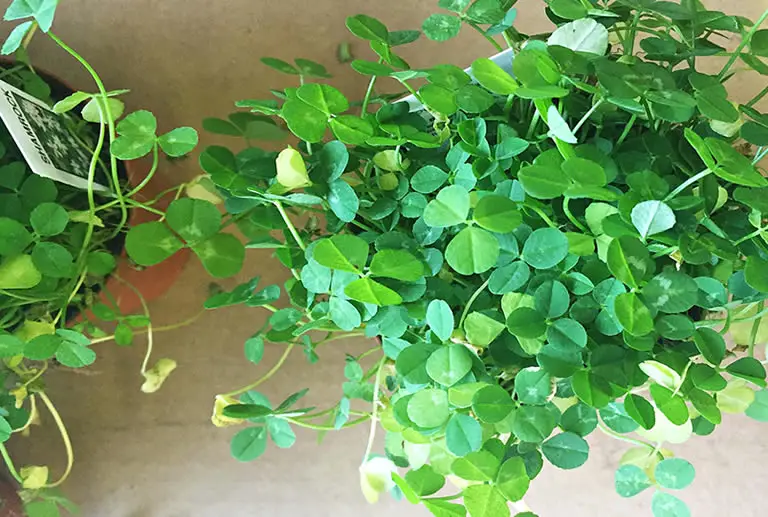
Whether you are preparing for St. Patrick’s Day, celebrating your Irish heritage or you just love the look of the three-leafed Shamrock, looking after this beautiful plant can be easy when you know how to do it right. But when the shamrock isn’t growing correctly it can develop a few different problems, the most common of which is dropping leaves, yellow leaves and brown leaves.
Table of Contents
Shamrock Plant Problems
The word “shamrock” is an anglicized version of the Irish/Gaelic word seamrog.
The literal English translation of “seamrog” is “little clover” and this aptly describes the leaves on the shamrock plant.
Although we always include the botanical name of a plant in all our guides we run into a little trouble when it comes to the shamrock. You see not all shamrocks are created the same.
First identify your specific shamrock plant
There are several different species of plant that are considered shamrocks. Below is a list of the most common plants considered to be shamrocks.
The 7 types of shamrock
Types of shamrock plants:
- Trifolium dubium – Lesser clover.
- Trifolium repens – White clover.
- Trifolium pratense – Red clover.
- Medicago lupulina – Black medick.
- Oxalis acetosella – Wood sorrel.
- Various other Trifolium.
- Various other Oxalis plants.
Not surprisingly, considering it is used in Irish logos from sports to Government bodies, the lesser clover, Trifolium dubium, is considered by most people in Ireland to be the true shamrock.
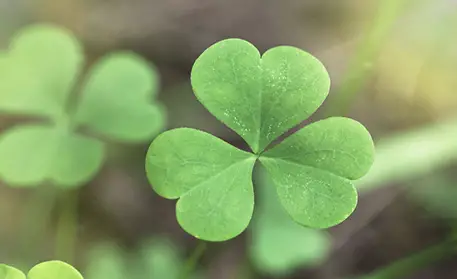
This belief that the Trifolium dubium is the true shamrock is not a strongly held view worldwide though, or even in Ireland for that matter, and you will find many different types of shamrock growing in many different places, with each plant having slightly different looking leaves from the others.
Having been originally born and raised in Ireland I also consider the Trifolium dubium, the lesser clover, to be a true Irish shamrock though I also consider the Oxalis acetosella (without the white flower) to be one too.
Both the Trifolium dubium and the Oxalis acetosella are the most common form of shamrock that I saw grown and worn (on St. Patrick’s Day) in Ireland, both North (Northern Ireland) and South (Republic of Ireland) in my youth, hence my view on them.
Having said that, any clover plant with three-leaved foliage can be considered to be a shamrock.
Luckily, the care of all shamrock plants are the same, because they are all clovers.
Before we move on I should note that the shamrock is not the same as a four-leafed clover.
Although they are both clover plants they are viewed differently, especially in Ireland.
Shamrocks have leaves that are divided into 3 petals per leaf while four-leaf clovers have 4 petals per leaf.
The difference between the two plants has less to do with the care and growing of the plant, which remains the same between the two, and more to do with historic and cultural reasons.
4 Reasons Why Your Shamrock Plant Is Drooping
The most common reason for a drooping shamrock plant is lack of water.
However, insufficient light, pest attacks and improper soil can all cause the leaves of a shamrock plant to wilt.
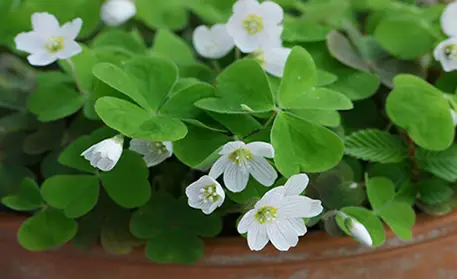
This drooping can be accompanied by brown or yellow leaves.
So, what reasons could there be for a drooping shamrock plant and what can you do about it?
There could be several reasons for a drooping shamrock plant as outlined below.
Reasons for wilting shamrock plants:
- Lack of water.
- Insufficient light.
- Pest attacks.
- Improper soil.
1. Shamrock drooping can be due to lack of water
Shamrock plants love water and it is a lack of water that is the most common cause for drooping shamrock plants.
Growing in naturally wet and fertile areas, shamrocks require regular watering especially if they are indoor potted plants, or they are grown outdoors in areas that don’t receive regular rainfall.
As a rule-of-thumb you should water your shamrock plant when the top layer of the soil starts to dry out.
Now, be aware that just because the shamrock loves water that doesn’t give you free range to over-soak the plant.
Always wait until the top layer of the soil starts to dry out. Don’t wait for days to take action when you notice a drying of the soil. As soon as the soil starts to dry, water the plant.
2. Shamrock drooping can be caused by insufficient light
Insufficient light can cause a shamrock plant to droop. It can also result in slow growth or stunted growth. In extreme cases it can kill the plant.
So, be sure that your shamrock plant has plenty of indirect sunlight. Do not place it in the path of direct, strong sunlight though.
Too much direct sunlight is just as bad as too little light.
So, be sure to position your plant in a well-lit area where it is not getting burnt by direct sunlight but is getting bright light during the daytime hours.
3. Using improper soil can cause drooping on a shamrock
Some gardeners and indoor plant enthusiasts will tell you to use a lightly sandy and loose soil for shamrock plants. I disagree with this. I mean have you seen Ireland?
A nutrient-rich moist soil is best for shamrock plants. A slightly acidic soil is best with a Ph of 6.1 to 6.5.
Though each shamrock plant type will prefer soil with a slightly different composition using the aforementioned soil will help all types grow well.
Smarocks love moist soil. Do ensure the soil has adequate drainage though. Shamrock plants may well love moist soil but they don’t like to be soaked.
Therefore make sure any indoor pots you use have sufficient drainage holes and that the soil around outdoor plants is not overly compacted.
You can use a standard house plant fertilizer once every few months during the growing period and skip this step when, and if, the plant goes dormant.
Many shamrock plants will grow happily all year round if positioned in a well lit area with moderately warm temperatures.
4. Pests can cause shamrock drooping
Pests can also cause the leaves of a shamrock plant to droop.
Although pests are the least likely culprit for a drooping shamrock plant you should investigate this as a potential cause if you are sure the other causes listed are not affecting your plant.
Using a good insecticide will help deal with any pests that may be attacking your shamrock plant.
If you want to be proactive and prevent pests from attacking your shamrock use a mixture of water and mild soap detergent in a spray bottle.
Use only 1 – 2 drops of soap per cup of water and put the spray bottle on a mist setting. Spray the leaves once per month or every other month.
Other Related Shamrock Plant Problems
Drooping leaves on a shamrock plant are often accompanied by a myriad of other problems.
I’ll cover these common problems here so you can deal with them at the same time as they are very often seen along with drooping leaves.
Why your shamrock plant is turning yellow
The drooping of shamrock plants is often accompanied by yellowing of the leaves.
Though, sometimes the leaves will turn yellow without drooping.
Yellow leaves on a shamrock plant are a much more normal sight than you may imagine.
Although there can be negative causes for this, yellowing leaves on a shamrock plant usually have natural causes.
Let’s look at the potential reasons for a yellowing shamrock plant.
Reasons for yellowing leaves on a shamrock plant:
- The plant is merely entering a dormant period.
- The plant is aging and/or dying.
- The plant is getting too much water.
Shamrock dormancy period may result in the yellowing of leaves
Although many indoor shamrock plants will grow and produce leaves all year round, when they are placed in a well-lit and temperate area, they can and often do move into a dormant stage around late spring or early summer.
When the plant starts to enter the dormant phase its leaves will yellow and die. This is completely normal and nothing to worry about.
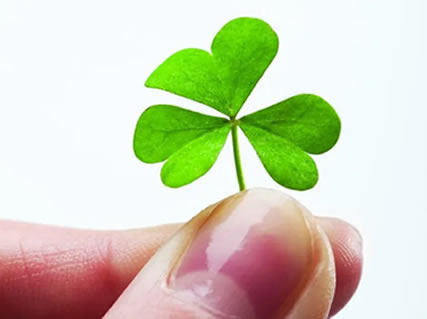 When shamrock leaves start to turn yellow and die, usually in late spring or early summer, your shamrock plants needs to rest.
When shamrock leaves start to turn yellow and die, usually in late spring or early summer, your shamrock plants needs to rest.
At this time move the plant to a place with less light (though not completely dark) and that is cooler than the area where it normally grows.
During its dormant phase do not fertilize the plant and water it very sparingly and only when the soil starts to dry out.
An aging shamrock plant can start to turn yellow
Nothing lives forever. Even Methuselah will die eventually.
When a shamrock plant starts coming to the end of its life it will start to turn yellow.
If your plant is dying you can try try the tips given in the section below, how to revive a shamrock plant, but if your plant has reached the end of its natural life cycle there is little you can do.
Best to take a cutting and start a new plant.
Before you give up on your shamrock plant though, be sure that it is not just entering a dormant stage and be certain that you have not been neglecting its care.
Too much water can turn a shamrock plant yellow
Although shamrock plants love water they are still living organisms that can drown.
A less common reason, but one that still occurs, for shamrock leaves turning yellow is due to overwatering the plant.
Soil (except the type that needs aerated) allows for oxygen to exist in the space between particles of soil.
If there is too much water in the soil then there is not enough air pockets to allow air to get to the roots.
This means the roots are getting a limited supply of oxygen and hence the plant will be unable to breathe.
Overwatering can happen even if you have a very conservative watering routine.
This can happen when the soil does not drain away water properly and can occur with both outdoor and indoor plants.
Soaked soil that sits in water can also cause irreparable damage the shamrock plant’s roots, making it extremely difficult for the plant to absorb enough nutrients to grow healthily.
This inability to absorb nutrients can even make it difficult for the plant to survive in extreme conditions.
Many shamrock plants that are restricted from absorbing iron from the soil due to too much water can also suffer from chlorosis.
Chlorosis causes the leaves of the plant to develop yellow spots rather than turning completely yellow.
So, be sure you get the watering routine right for your shamrock. Not too much water but not too little. Water when the top layer of the soil is dry.
Water it until the top layer is just damp and make sure the soil has sufficient drainage.
A pot or container that holds your shamrock plant should always have sufficient drainage holes in its bottom to allow water to drain away freely so the water doesn’t build up in the container and soak the soil.
Outdoor shamrock plants should be growing in soil that is not too compacted.
Why The Leaves Of Your Shamrock Plant Are Turning Brown
Yellow leaves are not the only thing that can accompany a drooping shamrock plant.
Brown leaves on a shamrock plant are common as well and are usually an indication that the leaves have died.
Brown leaves on a shamrock plant are a strong indication that the plant is not getting enough water.
However, mite attacks and fungal infections can also cause brown leaves.
They can also be an indication that the plant is entering a dormant period, though more often than not the leaves will be yellow if this is the case.
Most common reasons shamrock leaves turn brown:
- Lack of water.
- Mite attacks.
- Fungal infections.
- Plant dormancy.
Lack of water can result in shamrock leaves turning brown
Although the shamrock grows all across the European continent, and is not only an Irish plant, it truly thrives in rainy wet Ireland. So it should come as no surprise that the shamrock is a heavily water-dependent plant.
You should ensure your shamrock plant gets plenty of water. As I outlined above, ensure your shamrock plants gets plenty of water but be just as sure you do not drown it in water.
Water regularly throughout the week and water only when the top layer of the soil feels dry.
Mite attacks can cause browning leaves on shamrocks
When mites attack shamrock plants it can result in a browning of the leaves.
Just as aphids can cause a drooping of shamrock leaves other mites can cause the leaves to turn brown.
Be sure to check your plant for signs of pests if the leaves begin to turn brown. The mites that cause the browning effect will usually appear as small white spots on the leaves.
You can treat the plant with a mist spray of water/soap solution. Combine 2 drops of mild dish soap for every cup of water.
This is a fairly mild approach though and so I recommend taking a more aggressive stance.
The soap and water solution is ok for mild infestations, and for prevention, but this approach may take several applications and constant observation of the plant before you fully remove the pests.
By the time you have eliminated the pests they have have done some nasty damage to your plant.
I never take the chance with my plants and so take a much stronger approach.
I use the same stuff on all indoor houseplants for pest elimination and control as it works quickly and effectively usually in one application.
Fungal infections
Fungal infections can also result in shamrock leaves turning brown.
This is arguably the most serious cause.
Fungal rust usually usually only occurs with potted shamrock houseplants and is easy to spot.
Look for brown rust-like spots (sometimes orange) on the underside of the leaves.
If you see signs of fungal rust on your plant then you need to take immediate action.
You need to start by removing the plant from its pot. I recommended throwing the pot away but if it is expensive to replace then you must wash the pot thoroughly before putting new soil in it or the infection will simply come back.
Before repotting the shamrock plant be sure to wash the plant as well. Wash the roots lightly with running water being sure not to damage them.
Then wash the plant with neem oil. Neem oil is a naturally antifungal oil.
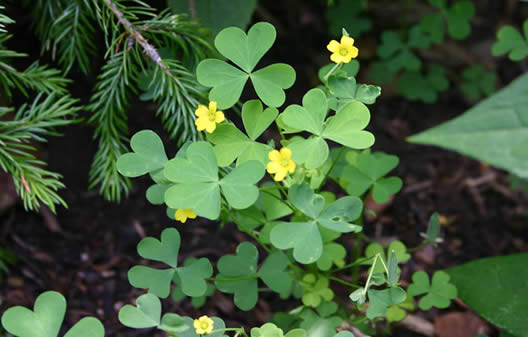
Once you wash the plant with neem oil use a chamomile tea rinse to help protect the leaves against the infection that is already in the plant’s system.
After you complete the above steps the brown rust effect on the bottom of the leaves should have disappeared.
If there are some leaves that have remain browned these leaves, and any others that are damaged beyond repair, should be removed from the plant.
Be sure to dispose of the leaves you removed from the plant in a responsible way.
Do not use them in a compost or dispose of them naturally.
Place them in a garbage bag to prevent reinfection and to eliminate the possibility of infecting other plants.
Keep a close eye on your shamrock plant for a few weeks checking it one per day to ensure there is no recurrence of the infection.
Remove and dispose of any potentially affected leaves immediately upon seeing signs of infection.
Plant dormancy can result in browning shamrock leaves
Although it is more common to see a shamrock plant going into dormancy producing yellow leaves, it is not unusual for the leaves to turn brown.
If there are signs that your shamrock plant is going dormant follow the advice given below.
How To Revive A Shamrock Plant
So, your shamrock plant looks like it is dying. What do you do to revive it?
The unfortunate truth is that if your shamrock plant has reached the end of its life cycle there is very little you can do to save the plant.
However, before you give up on it there may be a way to revive a shamrock plant from what seems like certain death.
Taking steps to save a seemingly dying shamrock plant is worth the very little effort it requires to try.
Start by assuming that your plant has merely went dormant and follow the advice I gave to rest it.
To revive a shamrock plant move it to a cooler, darker place and allow it time to rest. Do not fertilize it.
Water it infrequently and very sparingly only when the top layer of soil dries out.
Consider repotting it if the soil around it is compacted.
If you follow the advice above you will probably find that your shamrock plant springs back to life in the growing season.
As soon as you see signs of regrowth move the plant back to a warmer location that is well-lit but that does not get direct strong sunlight.
Thanks for reading! I'm Michael — houseplant fanatic and your Pinterest plant guide.
Follow me on Pinterest for fresh updates 🌿



